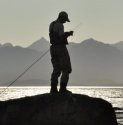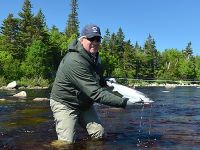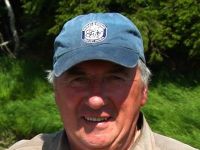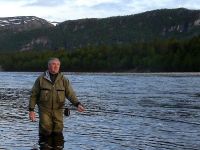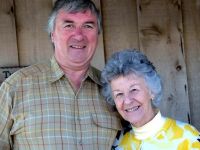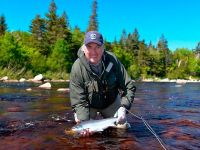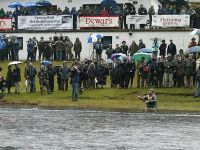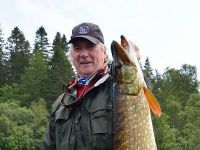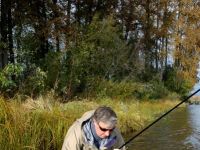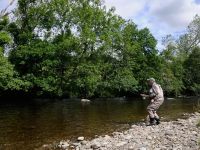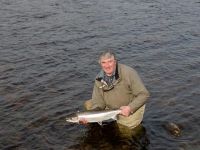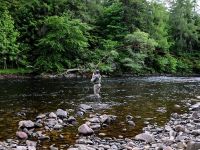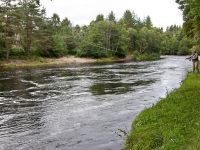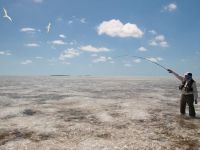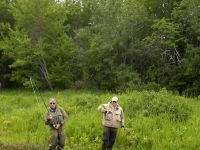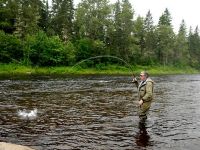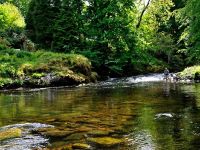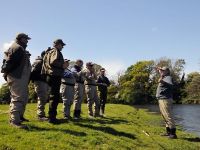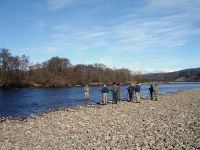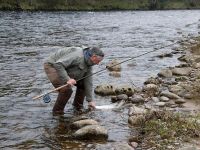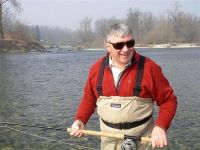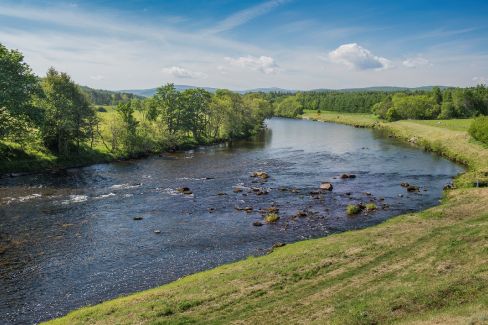Ally Gowans, from Scotland, is a professional photographer, writer, fishing instructor and guide who also provides top class tuition and instruction including Spey casting, underhand, roll and overhead casting with two-handed rods and all types of single handed casts. Ally's work has been featured in the top media resources of the industry and his qualifications include APGAI trout, salmon and fly tying, AAPGAI Master and FFF Master Instructor and Two Handed Casting Instructor.
Fd: How long have you been in the fly fishing world? How did you start?
Ally: My father introduced me to fishing when I was seven years of age. We had fly rods made from a South American wood called Greenheart, they were very heavy but much cheaper than the built bamboo cane rods that rich people could afford. As a young child holding such a rod for any length of time was tiresome and fly casting it was impossible so my early years were spent bait fishing with a fly rod something which has its own art and teaches lots about reading rivers and understanding fish. Such knowledge is very important for anglers. At the age of eleven I was able to start trying to fly cast. The lines were made from silk and were available as level lines or double tapered. I couldn’t afford either so I made a level line of sorts by greasing up a piece of flax sea fishing line, it didn’t cast well but I could get a few yards of it out and was able to catch a few small trout. I was a teenager earning some money by delivering newspapers before I could save up for a silk line and a better rod.
What is so special for you about the art of casting?
Casting for me is a resonance with a fly rod and line. It is aesthetically pleasing and hugely satisfying when occasionally I make one of these super casts, everything goes right and the line flies effortlessly to its target. Much better of course when a fish grabs the fly!
At university I studied maths, physics and engineering and these subjects have helped to appreciate and understand casting and interpret casting mechanics for my students.
How did you develop your casting skills? What styles of casting do you prefer?
Although I have some sort of reputation as a caster, I like to believe that my real skills are as a fly fisherman. Possibly the greatest complement I have ever received was from my dear friend Joan Wulff who invited me to fish with her on the Beaverkill. Joan didn’t fish, instead she took pictures as I fished dry fly amongst the trees in some difficult pocket water, casting in a myriad of different ways with either hand to cope with situations. Joan remarked that she got more pleasure watching me skilfully putting the fly down wherever I wanted to, than she ever would have done by fishing.
I think that some people have a natural aptitude for fly casting, described as better feel perhaps? However there is no substitute for fishing and practicing lots. Perhaps my humble beginnings, learning to cast with cumbersome homemade tackle helped me to develop the skill to cast with almost anything possible?
I’m not really sure if I prefer any particular style of fly casting. I have rods from 7ft to 18ft in length and use lines from AFFTA #3 to #15 and more. I think of casts as my tool box and use whichever is best suited for the job in hand. Because the Spey cast family doesn’t need much space and is less prone to tangling for practical reasons I tend to use these casts single or double handed probably much more than my American friends do.
You fish for many species in Scotland. Which is your favourite to pursue and why?
The most common species in Scotland are the indigenous brown trout, its sea run brethren the sea trout and Atlantic salmon. We have grayling in some rivers and rainbow trout in stocked lakes. I also fly fish for pike and occasionally in saltwater for pollack, sea bass, sea trout and mackerel. Each species has its season or conditions which suit its fishing best, this decides my choice of species for any given day. Mostly I fish for wild trout and salmon, pike on a few days when conditions are not conducive for them, and very rarely for stocked rainbows which don’t compare as sportfish to wonderful wild rainbows in the Americas.
What is it about teaching that you enjoy?
Teaching can be very satisfying and rewarding, I love meeting so many people and helping them to understand casting and perform better. Make no mistake however, teaching is not always a bundle of fun and it sometimes requires much resourcefulness, innovation and psychology to succeed in communicating and avoid my frustration!
Where do you guide and what makes the area special?
Nowadays, I guide mostly within 30 miles of my home where I am familiar with the fishing we have to offer. I would rather not guide than guide under false pretences. There are times when fishing here is tough and if anyone enquires I tell them that it’s tough rather than try to match impossible expectations. This part of Perthshire, Scotland is blessed with lots of fly fishing in rivers, large and small and many lochs (Scottish word for lakes). It is also an area of great scenic beauty and has other attractions for tourists.
What are your qualifications in fly fishing?
Fly fishing knowledge gathered over the past 60 years is I think my biggest asset, but I have taken most of the formal qualifications that are available. Unlike many of today’s candidates for tests and exams, I didn’t study to pass them, instead I waited until my ability was at least as good as that of anyone who might examine me and consequently I never had any trouble passing. I have APGAI in all disciplines (salmon, trout and fly tying), AAPGAI Master Salmon and trout and IFFF Master and THCI.
Do you do any conservation or management work?
I have done quite a bit for conservation over the years including being a Vice Chairman of the Salmon & Trout Association Scotland, and have supported several other organisations including the ASF and the Wild Fish Conservancy. I am still involved with the day to day management of my local fishing association and have in the past been involved the management of several others.
Tell us about some of the fly patterns you have created.
Like all fly tyers, I must have “created” lots of fly patterns over the years. I suppose this stems from the search for the infallible fly which if we ever found it would ruin fly fishing forever! What I appear to have done is to invent some flies that are apparently effective for Atlantic salmon, steelhead and other species. The real difference is that my flies swim better than other types because they have a long tail which adds to the action and supports the hook on a more level plane which makes them more like living creatures. Ally’s Shrimp and Cascade in their various colours and guises are best known.
Where do you get your inspiration for fly tying?
Inspiration can come from anywhere. Each time a fish refuses a fly I wonder if I could have made that fly more effective. Sometimes I find a potential fly making material that suggests a life form so I try to do something with it. Usually these experiments are unsuccessful but occasionally they work. Then comes the question, should I hide the new fly or should I reveal it?
Can you tell us about some of the work you have?
Most of the articles that I have written have been commissioned by magazines to feature a particular subject. To that extent the inspiration is theirs. I can usually write these without the need for much research because I have a lot of information in my head. Occasionally, I am asked to go somewhere and write about the fishing and the place and I have done a bit of that sort of travel writing over the years.
You are also an avid photographer. How did you get into photography?
My interest came from two directions really. Firstly, I used to do a bit of watercolour picture painting to supplement my income. Our weather in Scotland is changeable to say the least and it was much easier to take a photograph than spend a longer time sketching the subject. Secondly, I discovered that the guys who took the pictures to illustrate my magazine articles made more money than I did, so I started taking suitable pictures myself. In those days we used 35mm transparencies and very few people had the facilities to take pictures and process them quickly so my pictures were in high demand. Nowadays anyone can take pictures on their phone or digital camera so selling images from my photo library has become more difficult.
Is there anything in particular you like to shoot?
Good photography is all about light and the only time to get a really good picture is the instant that you see it. On assignment you have to get the shots for the job somehow. Often the best pictures are taken during morning or evening but if you want fly fishing action shots you can only do your best in the circumstances. I really like to take action shots in good light but that opportunity doesn’t happen often.
Do you have any future project coming up?
Several years ago I produced a DVD called “Spey Casting Made Easy” which was well acclaimed and is still selling via www.letsflyfish.com
I intended to produce another devoted to single handed casting but I never got around to that. Maybe this will be the year that I finally get it done?

